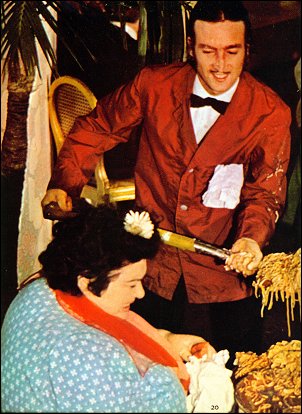Want to get a job in advertising?
The best way to get started is to buy the bible on the subject: the latest edition of Maxine Paetro‘s “How To Put Your Book Together And Get A Job In Advertising.”
 It has been in print for more than 30 years, but Maxine has been always updating it to reflect today’s rapidly changing reality.
It has been in print for more than 30 years, but Maxine has been always updating it to reflect today’s rapidly changing reality.
There’s great advice from ad legends including Jeff Goodby, Cliff Freeman and Helayne Spivak.
And way back in the early 1990s, Maxine was nice enough to ask me to contribute my thoughts on digital.
The original piece was titled “Have You Downloaded A Ford Lately?”. This year I updated my piece for the new edition. Here’s what I wrote.
How Do You Succeed In A Business That Hasn’t Been Reinvented Yet?
You are hurtling at 900 mph toward a career in advertising.
The awards book your eyes are glued to is the rearview mirror.
Oh, and here’s the brick wall you’re about to slam into: nobody knows what a “career in advertising” is going to mean anymore because it’s all being re-invented.
This is either the craziest time in the past eighty years to take a creative job in advertising, or the absolute best. Now, more than ever, advertising needs muscular, adventurous, wild minds. The very best minds — maybe yours — will not just create commercials, or digital widgets or viral videos, but will help invent what advertising can be.
OK, so now you know advertising is going to be a sort of glorious mess. How do you succeed in business that hasn’t been reinvented yet? I suggest five things.
1. Think Horizontal, Not Vertical. You’ll have to be great at creating ads if you want to get a job and keep it. But, that’s not enough.
 Get outside your comfort zone. Learn, learn, learn. Make friends with different kinds of people, and ask them to teach you: marketing MBAs, PR people, computer geeks, web analytics gurus, market researchers, lawyers, accountants, etc.
Get outside your comfort zone. Learn, learn, learn. Make friends with different kinds of people, and ask them to teach you: marketing MBAs, PR people, computer geeks, web analytics gurus, market researchers, lawyers, accountants, etc.
Don’t buy into the “us vs. them” nonsense, or the absurd fallacy that clients are idiots. These are sucker’s games invented by insecure creatives.
Develop a network of people who know things you don’t and nurture that network as if your career depends on it. Because in fact, it does.
2. Learn By Doing. Screw theory. Dive in, experiment. Start a blog. Get on Twitter. Put some pictures up on Flickr. Always, always, always look to the horizon and try to understand what’s coming next. Try different stuff. When you get lucky, try to understand why. And don’t be an arrogant knucklehead when you do get lucky. The universe has a ton of humble pie that it’s just waiting to feed to creative people whose egos get too big. And yes, in my fast I have been forced to eat my share.
3. Think Globally. Madison Avenue is not the  center of the ad universe anymore. Neither is America. There are billions of people out there just as creative as you are, and advertising can be outsourced just like everything else.
center of the ad universe anymore. Neither is America. There are billions of people out there just as creative as you are, and advertising can be outsourced just like everything else.
Advertising follows opportunity, and during your career that’s likely to happen in Asia. Pay close attention to what the CEOs of WPP, Publicis and Omnicom are saying and keep an open mind about it. Read as much as you can about other cultures, especially China and India. Learn the language and go visit if you can.
In your career, imagination won’t be enough. You need to constantly demonstrate that you are someone who makes problems shrink and possibilities grow. Speaking of which…
4. Always Focus On Possibility. Change will be constant, and many changes will be hugely disruptive. Some, deeply painful. Whatever happens, always ask yourself: “what new possibilities does this create?” Remember the most wrenching change you encounter may also lead to the best part of your advertising career. Stay open.
5. Talk To Strangers. Get in the habit of saying hello to people you don’t know, especially if they seem to offer challenging ideas. In fact if you think I’ve said anything useful here, you can start by saying hello to me. Follow me on Twitter (@tomcunniff) or look me up on social networking sites like LinkedIn. The only ground rules: cover letters, resumes, and self-promotion will earn you a place in my spam filter. Intelligent questions and insights will earn you respect and prompt replies.
 Advertising is undergoing radical change, so it favors people with guts now more than ever before. Don’t be afraid to be creative.
Advertising is undergoing radical change, so it favors people with guts now more than ever before. Don’t be afraid to be creative.
As the famous jazz pianist Thelonious Monk once said:
“The only cats worth anything are the cats who take chances. Sometimes, I play things I never heard myself.”
===
I hope some of my advice helps people get started. What other advice would you offer people who want to get their first job in advertising? Comments are welcome.
And don’t forget to buy the book. If you’re trying to get started it will kickstart your brain.
Photo Credits: Horizontal Bike from Kamshots on Flickr (Creative Commons license). Mumbai Traffic from Tom Cunniff on Flickr













Recent Comments